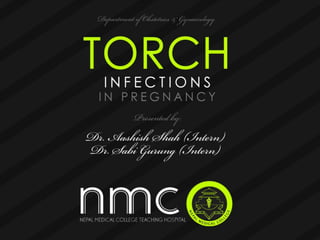
Torchinfectionsinpregnancy presentation-120302053700-phpapp02
- 2. AN OVERVIEW OF TORCH INFECTIONS THE TORCH COMPLEX TORCHcomplexisamedicalacronymforasetofperinatalinfections(i.e.infectionsthatarepassedfromapregnantwomantoherfetus).TheTORCHinfectionscanleadtoseverefetalanomaliesorevenfetalloss.Theyareagroupofviral,bacterial,andprotozoaninfectionsthatgainaccesstothefetalbloodstreamtransplacentallyviathechrionicvilli.Hematogenoustransmissionmayoccuratanytimeduringgestationoroccasionallyatthetimeofdeliveryviamaternal-to-fetaltransfusion.
- 3. Thecapitalization"TORCH”consistsof: T–TOXOPLASMOSIS O–Otherinfections(Syphilis,VaricellaZoster,ParvovirusB-19,Listerosis&CoxsackieVirus) R–RUBELLA C–CYTOMEGALOVIRUS H–HERPESSIMPLEXVIRUS–2 HepatitisBmayalsobeincludedamong"otherinfections", butthehepatitisBvirusisalargevirusanddoesnotcrosstheplacenta,henceitcannotinfectthefetusunlesstherehavebeenbreaksinthematernal-fetalbarrier,suchascanoccurinbleedingduringchildbirthoramniocentesis.
- 4. TOXOPLASMOSIS ToxoplasmosisisadiseasecausedbyanintracellularparasiteTOXOPLASMAGONDII. Humanacquisitionoftheinfectionoccursby: •Oocystcontaminatedsoil,salads,vegetables. •Ingestionofraworundercookedmeatcontainingtissuecysts(Sheep,pigsandrabbitsarethemostcommonmeatsources). •Outbreaksoftoxoplasmosishavealsobeenlinkedtotheconsumptionofunfilteredwater.
- 6. •Serafromrandomlyselected345pregnantNepalesewomenaged16-36yearsand13womenwithbadobstetrichistory(BOH)weretestedforthepresenceofToxoplasmaantibodiesusingmicrolatexagglutination(MLA)andELISAmethods. •Theoverallprevalencewas55.4%(191/345). •Prevalencewasslightlyhigher(59.0%)inolderage-group(27-36years)comparedwithyoungerage-group(16-26years)(52.2%). •InpatientswithanexistingHIVinfection,toxoplasmosisisanimportantoppurtunisticinfectionwithconsiderablemorbidityandmortalityespeciallyinthepregnantwomen.
- 7. CLINICALFEATURES: •Inmostimmunocompetentindividuals,includingchildrenandpregnantwomen,theinfectiongoesunnoticed. •Inapproximately10%ofthepatientsitcausesaself- limitingillness,mostcommonlyinthe25-35yearsagegroup. •Painlesslymphadenopathy(LocalorGeneralised)isthemostcommonpresentingfeature.Cervicallymphnodesareinvolvedinparticular.Themesenteric,mediastinalortheretroperitonealnodesmayalsobeinvolved. •Otherfeaturesinclude–Malaise,Fever,Fatigue,Musclepain,Sorethroatandheadache.
- 8. •Completeresolutionusuallyoccurswithinafewmonths, althoughsymptomsandlymphadenopathytendtofluctuateunpredictablyandsomepatientsdonotrecovercompletelyevenforayearormore. •Sometimesthepatientmayalsodevelopencephalitis, hepatitis,pneumonitisandmyocarditis. •Retinochoroiditisisnearlyalwaystheresultofcongenitalinfection.
- 9. CONGENITAL TOXOPLASMOSIS •Acutetoxoplasmosis,mostlysubclinical,affects0.3-1%ofpregnantwomen,withanapproximately60%transmissionratetothefetuswhichincreaseswithincreasinggestation. •Primarymaternalinfectioninpregnancy– Infectionratehigherwithinfectionin3rdtrimester. Fetaldeathhigherwithinfectionin1sttrimester. •Congenitaldiseaseaffectsapproximately40%ofinfectedfetuses,andismorelikelytobeseverewithinfectionearlyingestation. •Manyfetalinfectionsarealsosubclinicalatbirthbutthelong-termsequelaeincludehydrocephalus,microcephalyandretinochoroiditis.
- 10. INVESTIGATIONS: •Intheimmunocompetentpatient–Serologyisoftendonewhileintheimmunocompromisedthediagnosisoftenrequiresthedirectdetectionofparasites. •SABIN-FELDMANDYETEST(IndirectFluorescentAntibodyTest)–detectstheIgG–Antibody. Recentinfectionisindicatedbyafour-foldincreaseintitrewhilepeaktitresof1/1000ormorearereachedwithin2monthsofonsetofinfection. •ThedetectionofToxoplasmaspecificIgM-Antibodymaybeusefulinconfirmingacuteinfections.However,falsepositivesorpersistenceofIgM-Antibodiesforyearsafterinfectionmakeinterpretationdifficult.NegativeIgM- Antibodyvirtuallyrulesoutacuteinfection.
- 11. Toxoplasma Gondii in fluorescent stain
- 13. TREATMENT: •Inimmunocompetentsubjects,uncomplicatedtoxoplasmosisisself-limitingandrespondspoorlytoanti- microbialtherapy. •InPREGNANTWOMENwithanestablishedrecentinfection,SPIRAMYCIN(3gdailyindivideddoses)shouldbegivenuntilterm. •Oncefetalinfectionisestablished,treatmentwithSULFADIAZINEANDPYRIMETHAMINEplusCALCIUMFOLINATEisrecommendedasSPIRAMYCINdoesnotcrosstheplacentalbarrier.
- 14. OTHER INFECTIONSVARICELLAZOSTER •VaricellaZosterisamemberoftheherpesvirusfamily. •VaricellaalsoknownasChickenpox,istheacuteprimarydisease. •IncubationPeriod–15daysandiscommunicable2daysbeforeand5daysaftertheonsetofrash. •AfteraninitialepisodeofinfectionwithVaricellaZosterleadingtoChickenpox,thevirusmaypersistinalatentstateintheposteriorrootgangliaofthespinalcordforyear.ReactivationresultsinHerpesZoster.
- 15. •Itishighlycontagious,self-limitingdiseaseofchildhoodthatistransmittedbyrespiratorydropletsorclosecontact. •Itisusuallyacquiredby90%ofthepopulationbeforethereproductiveage,thusmostwomenareimmunebeforetheybecomepregnant. •TheincidenceofVaricellainpregnancyis0.7/1000. •CLINICALFEATURESincludevesiculareruptionsoftenonmucosalsurfacesfirstfollowedbyarapiddisseminationinacentripetalpattern.Newlesionsappearevery2-4daysandeachcropisassociatedwithfever.Therashprogressesfrommaculestovesiclesandthentopustulein24hours.
- 17. •Maternalvaricellainfectioninthefirst20weeksofpregnancycancauseVARICELLAEMBRYOPATHYalsocalledCongenitalVaricellaSyndromeinapproximately1-2%ofcasescharacterisedbyhallmarkcicatriciallesionsindermatomalpattern,limbhypoplasia,contracturesandcanalsoinvolvetheeyeandcentralnervoussystem.Theprognosisispoorifaninfantbeinfected.DiagnosisisbyPrenatalUltrasoundandMRImayshowOligohydramnios, IUGR,hydrops,limbdeformitiesandmicrocephaly. •However,theriskofcongenitalvaricellasyndromeisnegligiblebecauseantibodiesinthematernalbloodpreventthevirusfromcrossingtheplacentaandinfectingthefetus. •In1994,Endersandcolleaguesshowednoclinicalevidenceofinfectionininfantsbornto366womenwithVaricellaZosterinpregnancy.
- 18. DIAGNOSIS: Isprimarilyclinical,byrecognitionoftherash.Ifnecessary, itcanbeconfirmedbydetectionofantigen(DirectImmunofluroscence),PCRorbyVIRALCULTUREoftheaspiratedVesicularFluid. TREATMENT: ACYCLOVIR(800mg5timesdailyat4hourlyintervalsfor7days)orACYCLOVIR5mg/kg8hourlyIVuntilpatientisimprovingisaClass-CantiviralagentusedinthetreatmentofVaricellaZoster.OralAcyclovirhasbeenshowntosignificantlyreducesymptoms,durationandintensity. •ManystudieshaveshowedthesafetyofAcycloviruseinpregnancy.In1993, CenterforDiseaseControlpublisheddatashowingnoriskoffetalabnormalitiesinpatientsexposedinthefirsttrimesterreceivingAcyclovir. •ThenewerdrugslikeVALACYCLOVIRandFAMCYCLOVIRhaveabetterbio-availabilityandalessfrequentdosingthanAcyclovirwithsimilarefficacy.
- 19. PARVOVIRUSB-19INFECTION: •ParvovirusB-19virusisasmallsinglestrandedDNAvirusandhasapredilectionforrapidlydividingcellsparticularlytheerythroblasts.Manyinfectionsaresub- clinical. •IncubationPeriod–14-21days. •CLINICALFEATURES:ProdromalFever,CoryzalSymptoms,andacharacteristic“Slapped-cheekrash”, ImpairedErythropoiesiscausingmildanemiaandpolyarthropathy. •Trans-placentalfetalinfectioncanoccurduringthefirsttwotrimestersofpregnancywithanimpactonthefetalbonemarrow.Itcauses10-15%ofnon-immune(Non- Rhesusrelated)HYDROPSFETALIS.
- 21. TREATMENT: •Infectionisusuallyself-limiting. •SymptomaticrelieffromArthriticsymptomsmayberequiredbytheuseofanalgesics. •PregnantwomenshouldavoidcontactwithcasesofParvovirus-B19infection. •Ifexposed,SEROLOGYshouldbedonetoestablishwhethertheyarenon-immune. •PassiveprophylaxiswithNORMALIMMUNOGLOBINhasbeensuggested. •ThepregnancyshouldbemonitoredcloselybyUSG,sothatHydropsFetaliscanbetreatedbyFetalTransfusion.
- 22. SYPHILIS: •Syphilisiscausedbyinfection,throughabrasionsintheskinormucousmembraneswiththespirochaeteTREPONEMAPALLIDUM. •Inadultstheinfectionisusuallysexuallyacquired, howevertransmissionbykissing,bloodtransfusionandpercutaneousinjuryhavealsobeenreported. •Infectionmayremainlatentthroughoutorclinicalfeaturesmaydevelopatanytime. •Allwomenshouldhavesyphilisserologycarriedoutinthefirsttrimesterofpregnancyoratthefirstantenatalvisit. •Womenatariskofacquiringsyphilisshouldhaveafurthertestinthe3rdtrimesterpreferablyat28-30weeks.
- 23. CONGENITALSYPHILIS– •CongenitalSyphilisisrarewhereantenatalserologicalscreeningispractised. •Treponemalinfectionmaygiverisetoavarietyofoutcomesafter4monthsofgestationwhenthefetusbecomesimmunocompetent: 1.MiscarriageorStill-birth,Prematureoratterm. 2.Birthofasyphiliticbaby(verysickbabywithhepatosplenomegaly,bullousrashandperhapspneumonia). 3.BirthofababywithlatentinfectionwhoeitherremainswellordevelopsCongenitalSyphilislaterinlife.
- 24. •SyphilismaybedividedasEarlyorLatentSyphilis. •CLINICALFEATURES: •IncubationperiodofEarlySyphilisisusually14-28dayswithawiderangeof9-90days. •Theprimarylesionorchancredevelopsatthesiteofinfectionusuallyonthegenitalareaandmayalsodeveloponthevaginalwallandthecervix. •After6-8weeksthetreponemesdisseminatetoproduceamulti-systemdisease.Constitutionalfeaturessuchasfever, malaiseandheadachearecommon.Over75%patientspresentwitharashonthetrunkandlimbsthatlaterinvolvesthepalmsandsoles. •Generalisednon-tenderlymphadenopathyispresentinover50%patients.
- 25. •Oftenfeaturessuchasmeningitis,cranialnervepalsies, hepatitis,gastritis,glomerulonephritisandanterior/posterioruveitisareseen. INVESTIGATIONS: SEROLOGICAL TESTS FOR SYPHILIS Non-treponemal( Non-specific)tests: •VeneralDiseases Research Laboratory ( VDRL ) Test •Rapid Plasma ReaginTest Treponemal(Specific) antibody tests: •Treponemalantigen-basedenzyme immunoassay (EIA) for IgGand IgM •T. Pallidumhaemagglutinationassay (TPHA) •T. PallidumParticle agglutination assay (TPPA) •Fluorescent treponemalantibody-absorbed (FTA- ABS) test
- 27. TREATMENT: •In early latent stage: single dose of 2.4 Million units Benzathine Penicillin G IMIn late latent stage: 3 doses of 2.4 million units of Benzathine Penicillin GIM is given. It is given once in a week. •ERYTHROMYCINSTEARATEcanbegivenifthereisPenicillinhypersensitivity,butitcrossestheplacentapoorly.Thetreatmentofsyphiliscanbeconsideredadequateifitiscompletedbyatleast30daysbeforedeliveryorthereisadocumentef4-folddropinRPRtitre.
- 28. •ThenewbornbabymustthereforebetreatedwithacourseofPenicillinandconsiderationgiventore-treatingthemother. •SuccesshasalsobeenachievedwithCEFTRIAXONE250mgIMfor10daysinmanycases. All pregnant women testing positive for Syphilis should also be screened for HIV.
- 29. COXSACKIEVIRUSINFECTION: •ThevirusisamemberofthePicornaviridaeandhaveasingle-strandedRNA.Itmaycauseclinicallyinapparentinfectioninthemotherbutmayprovefataltothefetusortheinfantbyincreasingcongenitalmalformations. •Infectionisspreadfrompersontoperson.Thevirusispresentinsecretionsandbodyfluidsofinfectedpeople. •FetaldeathmaybecausedbyviraemiaresultinginHepatitis,MyocarditisandEncephalomyelitisduetoplacentitisandclinicalchorioamnionitis. •Thevirusmaybegrownfromtheamnioticfluidortheneonatalspinalfluid.PCRcandetect66-90%oftheinfection.
- 30. CLINICALFEATURES:CommonCold,Rash,diarrhoea, sorethroat.Severemanifestationsincludemeningitis, encephalitis,severechestpain,myopericarditis. TREATMENT: •ThereisnospecificmedicationknowntokilltheCoxsackievirus. •Fortunately,thebody’simmunesystemisusuallyabletodestroythevirus. •SomereportssuggestthattheremightbeabenefittoIVImmunoglobulinwhichismadefromhumanserumandcontainsantibodies. •TreatmentforMyocarditisissupportive.
- 32. LISTEROSIS: •Recentsurveyshaveshownthat4%ofpregnantwomenharborLISTERIAMONOCYTOGENS,aGram-positivebacteriainthecervix. •Trancplacentalinfectionscanoccurfromaninfectedmother. •SuchpatientshaveInfluenzalikesymptoms,prematuredeliveryanddirtybrownamnioticfluid,fever,myalgia, choriamnionitisandabortions. •BabiesborntothesemothersmaygetinfectedtransplacentallyorduringdeliverywithahighmorbidityandmortalityduetoPyogenicMeningitis.
- 33. INVESTIGATIONS : •DiagnosisismadebyBlood/CSFCulture,apositivefluoroscentantibodytestandcultureofstomachcontent, liquor. TREATMENT: •ThemosteffectiveregimenconsistsofIVAMINOPENICILLIN(AMOXYCILLIN/AMPICILLIN)+ANAMINOGLYCOSIDE. •PatientsallergictoPenicillinmaybegivenacombinationofSulfamethoxazole/Trimethoprim. •Dietaryprecaution:Pregnantwomenareadvisedtoavoidhigh-riskproductslikeundercookedchicken,fish,rawvegetablesandsoftcheese.
- 34. RUBELLA : •Rubella,commonlyknownasGermanmeasles,isadiseasecausedbytherubellavirusatogavirusthatisenvelopedandhasasingle-strandedRNAgenome. •Thisdiseaseisoftenmildandattacksoftenpassunnoticed.Thediseasecanlastonetothreedays. Childrenrecovermorequicklythanadults. •InfectionofthemotherbyRubellavirusduringpregnancycanbeserious;ifthemotherisinfectedwithinthefirst20weeksofpregnancy,thechildmaybebornwithcongenitalrubellasyndrome(CRS),whichentailsarangeofseriousincurableillnesses.Spontaneousabortionoccursinupto20%ofcases.Thevirushasteratogenicpropertiesandiscapableofcrossingtheplacentaandinfectingthefetuswhereitstopscellsfromdevelopingordestroysthem.
- 35. •Acquired(i.e.notcongenital)rubellaistransmittedviaairbornedropletemissionfromtheupperrespiratorytractofactivecasesandreplicatesinthenasopharynxandlymphnodes. •Thevirusmayalsobepresentintheurine,Faecesandontheskin.Thereisnocarrierstate:thereservoirexistsentirelyinactivehumancases. •Thediseasehasanincubationperiodof2to3weeks. •Inmostpeoplethevirusisrapidlyeliminated.However,itmaypersistforsomemonthspostpartumininfantssurvivingtheCRS.Thesechildrenareasignificantsourceofinfectiontootherinfantsand,moreimportantly,topregnantfemalecontacts.
- 36. CLINICAL FEATURES : •Germanmeaslescausessymptomsthataresimilartotheflu.Theprimarysymptomofrubellavirusinfectionistheappearanceofarash(exanthem)onthefacewhichspreadstothetrunkandlimbsandusuallyfadesafterthreedays. •Thefacialrashusuallyclearsasitspreadstootherpartsofthebody.Othersymptomsincludelowgradefever, swollenglands(suboccipital&posteriorcervicallymphadenopathy),jointpains,headacheandconjunctivitis.Theswollenglandsorlymphnodescanpersistforuptoaweekandthefeverrarelyrisesabove38degreescentigrate.Therashdisappearsafterafewdayswithnostainingorpeelingoftheskin. •.
- 37. CONGENITAL RUBELLA SYNDROME •Congenitalrubellasyndrome(CRS)ischaracterizedby: Intrauterinegrowthrestriction Intracranialcalcifications Microcephaly Cataracts Cardiacdefects(mostcommonlypatentductusarteriosusorpulmonaryarterialhypoplasia). Neurologic disease (with a broad range of presentations, from behavior disorders to meningoencephalitis) Osteitisandhepatosplenomegaly
- 39. •Mostofthesecomplicationsdevelopininfantsborntomotherswhoacquirerubellainfectionduringthefirst16weeksofpregnancy. •90%ofinfantspresentwithsomefindingofcongenitalrubellaifinfectionoccurswithinthefirst12weeks,and20% presentwithcongenitaldiseaseiftheinfectionoccursbetweenweeks12and16. •Cataractsresultswheninfectionoccursbetweenthethirdandeighthweekofgestation,deafnessbetweenthe3rdand18thweek,andheartabnormalitiesbetweenthe3rdand10thweek.
- 41. TREATMENT : •Rubellainfectionsarepreventedbyactiveimmunisationprogramsusinglive,disabledvirusvaccines.Twoliveattenuatedvirusvaccines,RA27/3andCendehillstrains, areeffectiveinthepreventionofadultdisease. •ThevaccineisnowusuallygivenaspartoftheMMRvaccine.TheWHOrecommendsthefirstdoseisgivenat12to18monthsofagewithaseconddoseat36months. Pregnantwomenareusuallytestedforimmunitytorubellaearlyon.Womenfoundtobesusceptiblearenotvaccinateduntilafterthebabyisbornbecausethevaccinecontainslivevirus.
- 42. •ThereisnospecifictreatmentforRubella;however, managementisamatterofrespondingtosymptomstodiminishdiscomfort. •Treatmentofnewlybornbabiesisfocusedonmanagementofthecomplications. •Congenitalheartandcataractscanbecorrectedbydirectsurgery. •Managementforocularcongenitalrubellasyndrome(CRS)issimilartothatforage-relatedmaculardegeneration,includingcounseling,regularmonitoring, andtheprovisionoflowvisiondevices,ifrequired. •Rubellainfectionofchildrenandadultsisusuallymild,self- limitingandoftenasymptomatic.TheprognosisinchildrenbornwithCRSispoor.
- 43. CYTOMEGALOVIRUS INFECTION : •CMVisadouble-strandedDNAherpesvirusandrepresentsthemostcommoncongenitalviralinfection. •TheCMVseropositivityrateincreaseswithage. Geographiclocation,socioeconomicclass,andworkexposureareotherfactorsthatinfluencetheriskofinfection. •CMVinfectionrequiresintimatecontactthroughsaliva, urine,and/orotherbodyfluids. •Possibleroutesoftransmissionincludesexualcontact, organtransplantation,transplacentaltransmission, transmissionviabreastmilk,andbloodtransfusion(rare).
- 44. •Primary,reactivation,orrecurrentCMVinfectioncanoccurinpregnancyandcanleadtocongenitalCMVinfection. •Transplacentalinfectioncanresultinintrauterinegrowthrestriction,sensorineuralhearingloss,intracranialcalcifications,microcephaly,hydrocephalus, hepatosplenomegaly,delayedpsychomotordevelopment,thrombocytopeniaand/oropticatrophy. •VerticaltransmissionofCMVcanoccuratanystageofpregnancy;however,severesequelaearemorecommonwithinfectioninthe1sttrimester,whiletheoverallriskofinfectionisgreatestinthe3rdtrimester. •Theriskoftransmissiontothefetusinprimaryinfectionis30%-40%.
- 46. •Thetransmissionratetothefetusisbetween30-50% accordingtotheOrganizationofTeratologyInformationService(OTIS). •Ofthosebabieswhobecomeinfected,only10-15%showsignsofcongenitalCMVafterprimarymaternalinfection. •CongenitalCMVaffectsabout0.2-2.5%ofbabiesworldwide. •Ofthese,only1-10%ofthebabiesbornwiththeCMVinfectionwillhavesymptomsatbirthandanother10-15% maynotshowanysymptomsatbirth,butstillmayhavelongtermaffectssuchashearinglossandlearningdisabilities.
- 48. DIAGNOSIS & MANAGEMENT : •Serologic testing in women with suspected Cytomegalovirus (CMV) •Amniocentesis •Ultrasonography •Quantitative polymerase chain reaction (PCR) for viral DNA in amniotic fluid •Fetal magnetic resonance imaging (MRI) (considered but not recommended) •Intravenous treatment with CMV-hyperimmune globulin •Ganciclovirtreatment.
- 49. HERPES SIMPLEX VIRUS -2 INFECTION : •Herpessimplexvirus(HSV)infectionisoneofthemostcommonviralsexuallytransmitteddiseasesworldwide.Theprimaryinfectionofthemothermayleadtosevereillnessinpregnancyandmaybeassociatedwithvirustransmissionfrommothertofoetus/newborn. •Sincetheincidenceofthissexuallytransmittedinfectioncontinuestoriseandbecausethegreatestincidenceofherpessimplexvirusinfectionsoccurinwomenofreproductiveage,theriskofmaternaltransmissionofthevirustothefoetusorneonatehasbecomeamajorhealthconcern.
- 50. •Apregnantwomanwhoacquiresgenitalherpesasaprimaryinfectioninthelatterhalfofpregnancy,ratherthanpriortopregnancy,isatgreatestriskoftransmittingthesevirusestohernewborn. •AdditionalriskfactorsforneonatalHSVinfectionincludetheuseofafoetal-scalpelectrodeandtheageofthemother<21years. •HerpesSimplexVirus-2isaDNAvirusthatbelongstoAlphaherpesvirinaefamily. •HSV-2ismostcommonlyfoundinthelumbosacralganglia. •ThemostimportantHSVinfectionduringpregnancyistheprimarygenitalHSVinfection.
- 51. •PrimaryHSVinfectionsinpregnantwomencanresultinmoreseverediseasesthanthatinnon-pregnantones. •Inparticular,gingivostomatitisandvulvovaginitisherpeticatendtowardsdissemination.Asaresult,womencandevelopdisseminatedskinlesionsassociatedwithvisceralinvolvementsuchashepatitis,encephalitis, thrombocytopenia,leucopoeniaandcoagulopathy. •AlthoughdisseminatedHSVinfectionisuncommoninpregnancy,themortalityisabout50%.Inparticular, pregnantwomenwithprimarymucousmembraneinfectionduringthe3rdtrimester,haveanincreasedriskfordisseminationandtheycouldtransmitHSVtotheirbabiesduringvaginaldelivery.
- 52. •ThegreatmajorityofrecurrentgenitalherpesisduetoHSV-2becausethisvirusreactivatesmorefrequentlythanHSV-1. •RecurrentepisodesofHSVinfectionarecharacterizedbythepresenceofantibodyagainstthesameHSVtypeandtheherpesoutbreaksareusuallymild(7–10days)withlessseveresymptomsthanthefirstepisode. •Prodromalsymptoms(itching,tingling,neuralgia)mayoccurhoursordaysbeforearecurrentherpesepisode. •Theapparentlyasymptomaticphasesbetweenclinicaloutbreaksofgenitalherpesareimportant,sinceHSVcanreactivateperiodicallyinlatentlyinfectedcellsofsensorygangliatravellingviatheneuronalaxonsbacktothegenitalmucosa,withoutclinicalsignsorsymptoms.Thismechanismisknownasasymptomaticvirusshedding.
- 53. •AsymptomaticsheddinghasbeenshowntobehigherinwomenwithHSV-2infectioncomparedwiththosewithHSV-1. •Althoughthereisasmallriskofverticaltransmission, recurrentgenitalherpesmustberegardedasthemostcommoncauseofneonatalinfectionsandthepassagethroughaninfectedbirthcanalisthemostprobablerouteoftransmission. •Inrecurrentinfectionsassociatedwithclinicalsymptoms, theriskofneonataldiseaseisreduceddramaticallybyCaesareansection.
- 55. DIAGNOSIS : •Clinicaldiagnosisofgenitalherpesislimitedinaccuracy. First,HSVisonlyoneofseveraldiseasescharacterizedbygenitalulcers.Moreimportantly,manypersonsareunawarethattheirsymptomsarethoseofherpes. •Thetypicallesionsmaynotappear,andrecurrencesmaybeatdifferentlocationsalongadermatome.Womenmayexperienceonlyprodromalsymptoms,suchasburningortingling;havesingleulcers,fissures,orerosion;orexperienceerythemaoredemaastheprimarysymptom. •AvailabletestsforherpesincludebothcultureandPCR- DNAtestingforviralshedding,andtheuseofbloodteststoscreenforpreviousexposure.
- 56. MANAGEMENT : •TheAmericanCongressofObstetriciansandGynecologists(ACOG)recommendsthatwomenwithactiverecurrentgenitalherpesshouldbeoffered– •Suppressiveviraltherapyfrom36weeksuntildelivery Valacyclovir500mgorallyBDOR Acyclovir400mgorallyTDS. •Transplacentalinfectionofthefetusisrareduringpregnancy.IntrauterineHSVinfectionhasuncommonlybeenassociatedwithskinlesions,chorioretinitis, microcephaly,hydranencephaly,andmicrophthalmia.
- 57. •WhileprimaryHSVinfectionsinthefirsttrimesterareassociatedwithhigherratesofspontaneousabortionandstillbirth,infectionlaterinpregnancyappearsmorelikelytobeassociatedwithpretermlabororgrowthrestriction. •Ofgreatestconcernistheriskofprimaryinfectionacquiredatbirthwhichcouldleadtoherpeticmeningitis.Theinfectionrateis34to80%forinfantsbornvaginallyduringaprimaryinfection. •Cesareansectionisrecommendedforallwomeninlaborwithactivegenitallesionsorprodromalsymptomssuchasvulvarpain. ForpatientswithpretermprematureruptureofmembranesremotefromtermcomplicatedbyrecurrentmaternalHSVinfection,therisksofprematurityshouldbeweighedagainsttheriskofneonatalHSVdiseaseinconsideringexpectantmanagement.Prophylactictreatmentwithantiviralagents(eg,acyclovir)maybeconsideredifexpectantmanagementischosen.
- 59. THE TORCH TEST : •TheTORCHtestisusedtoscreenpregnantwomenandnewbornsforantibodiestotheinfectiousdiseasesincludedinthepanel,ifeitherthemotherornewbornhassymptoms.Thebloodtestcandetermineifthepersonhashadarecentinfection,apastinfection,orhasneverbeenexposed. •ThetestisorderedwhenapregnantwomanissuspectedofhavinganyoftheTORCHinfections.Theseinfectionscanbeseriousiftheyoccurduringpregnancybecausetheycancrosstheplacentafromthemothertothedevelopingfetusandcancausecongenitaldefectsinthenewborn.
- 60. •Resultsareusuallygivenaspositiveornegative, indicatingthepresenceorabsenceofIgGandIgMantibodiesforeachoftheinfectiousagentstestedforwiththepanel.A"normal"resultisnegative(undetectable)IgMantibodyinthebloodofthemotherornewborn. •PresenceofIgMantibodiesindicateseitheracurrentorrecentinfection.ApositiveIgMresultinanewbornindicateshighlikelihoodofinfectionwiththatorganism. IgMantibodiesproducedinthemothercannotcrosstheplacenta,sopresenceofthistypeofantibodystronglysuggestsanactiveinfectionintheinfant.PresenceofIgGandabsenceofIgMantibodyinaninfantmayreflectpassivetransferofmaternalantibodytothebabyanddoesnotindicateactiveinfectioninthatinfant.
- 61. •Likewise,thepresenceofIgMantibodyinapregnantwomansuggestsanewinfectionwiththevirusorparasite. •FurthertestingmustbedonetoconfirmtheseresultssinceIgMantibodymaybepresentforotherreasons. •IgGantibodyinthepregnantwomanmaybeasignofpastinfectionwithoneoftheseinfectiousagents.Bytestingasecondbloodsampledrawntwoweekslater, thelevelofantibodycanbecompared. •IfthesecondblooddrawshowsanincreaseinIgGantibody,itmayindicatearecentinfectionwiththeinfectiousagent.
- 62. REFERENCES •Davidson’s Principles & Practice of MEDICINE -21stedition •Novak’s Textbook of Obstetrics –10thedition •TORCH Infections in Pregnancy –VeenaGupta –JaypeePublication –2ndedition. •William’s Textbook of Obstetrics –23rdedition •Article on Torch infections in Pregnancy –THE BRITISH MEDICAL JOURNAL (BMJ) •Article on TORCH INFECTIONS in Pregnancy –AMERICAN COLLEGE OF OBSTETRICS & GYNAECOLOGY (ACOG)
